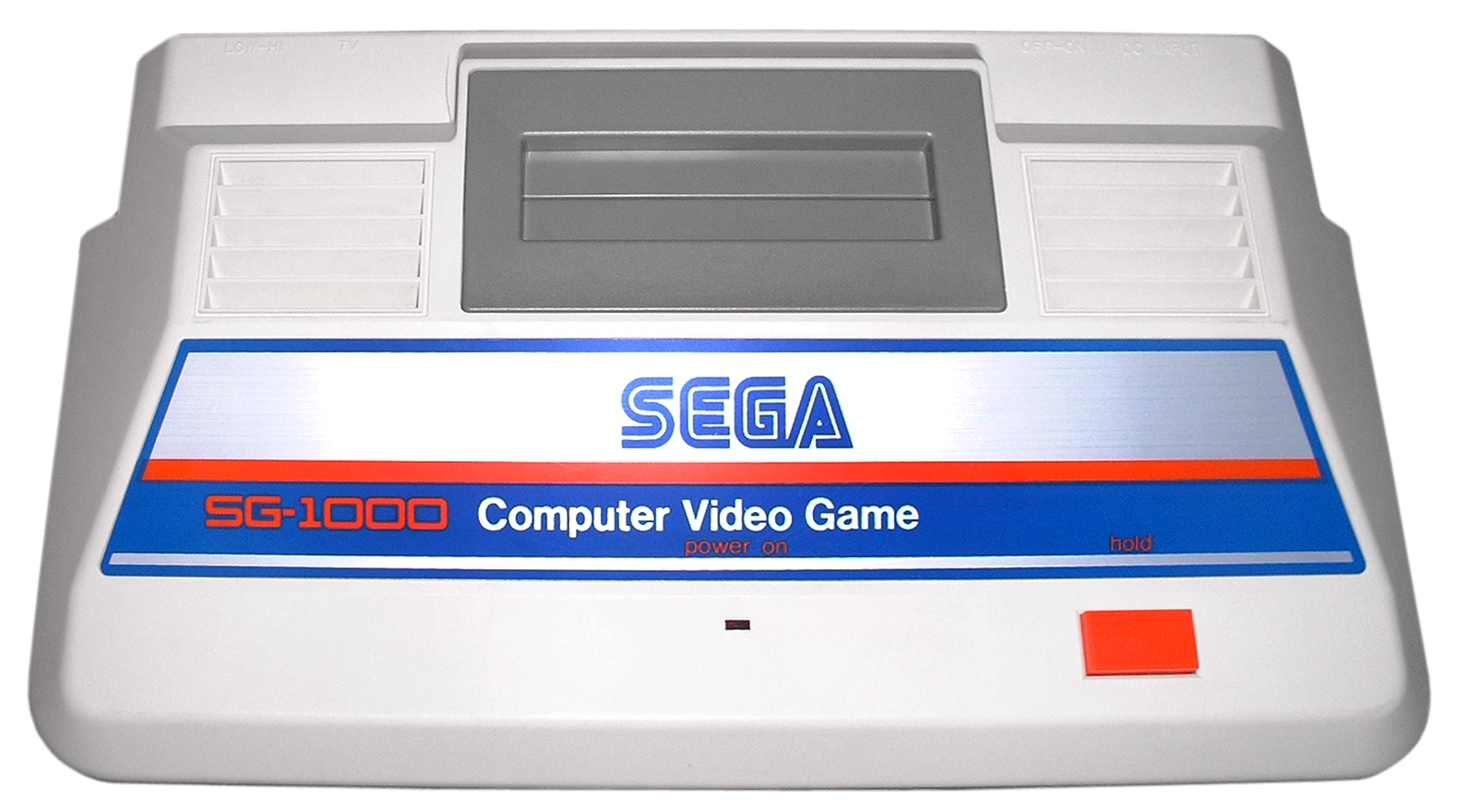
RELEASED: July 15th, 1983 (JP), 1983 (NZ)
PRICE: 15,000 yen
TECH SPECS: Z-80A CPU running at 3.58 Mhz, 8Kbits of RAM, 16Kbits of VRAM. Video Processor: TI-TMS9928A capable of 16 colors. Sound Processor: TI-SN76489 capable of 4 channel mono sound.
# OF GAMES: 68 standard cartridges, 29 Sega Cards
UPDATES: SG-1000 II – released July 1984 in Japan for 15,000 yen.
# OF UNITS SOLD: Unknown, but it is likely the poorest-selling console Sega ever released.
Prior to the SG-1000’s release, Sega had been an arcade game manufacturer only. With the arcade boom in the late 70s and the early 80s, the company flourished, producing games such as Head On, Turbo, Zaxxon, and Sub-Roc 3-D. By 1982, however, arcade revenues started to decline and Sega needed to find other ways to make money. Gulf & Western, the then-owners of Sega, asked Sega of Japan’s president, Hayao Nakayama, how they should proceed with business. He advised that they move into the then-fledgling home console market and the SG-1000 was born.
The SG-1000 was Sega’s first awkward step into the home console landscape, but don’t be shocked if you’ve never heard of it until today. The console was only released in Japan, Australia, New Zealand, and select parts of Europe, and was successful in exactly none of them. Thanks to the Famicom’s impact, the glut of consoles/home computers on the Japanese market, and the overall crappiness of the device, the SG-1000 was a relative failure, even upon release. The graphics of the majority of the games look terrible next to Famicom releases of the same time (the SG-1000 has roughly the power of a Colecovision), and the SJ-200 joystick has been criticized for being “stiff and unresponsive.” Like other consoles of the time, the joystick has a short cord length and is tethered to the console itself. This meant that, should the controller break, it would be incredibly difficult to replace. Couple ugly games and bad controls with a lack of third-party support, and it was clear that the SG-1000 wasn’t long for this world. This didn’t stop Sega from trying to extend the console’s lifespan, though.
If you grew up in the 90s, you know of Sega’s fondness for releasing an exorbitant amount of peripherals and unnecessary add-ons. This trend started with the SG-1000. Two add-ons of note include the Card Catcher, a device that allowed players to use Sega Cards on the console (Sega Cards were cheaper to produce than cartridges, but had less storage space on them – more on them in the ‘Peripherals’ section); and the SK-1100 keyboard. The keyboard cost almost as much as the system itself, and turned the SG-1000 (for all intents and purposes) into an altogether different device: the SC-3000, Sega’s one and only home computer. The SC-3000 was released in the same month as the SG-1000 and shares much of the console’s technical specs, as well. Because the SC-3000 is a computer and not a console, however, I will not be discussing it in detail on the site. Check SegaRetro for more information on the SC-3000.

Typing of the Dead 8-bit… engage.
In July 1984, Sega released the SG-1000 II in an attempt to right the wrongs of the initial iteration. The console retained the same internal components as the original, but had a number of external changes. Instead of a joystick with two buttons on the side, the controllers now resembled the Famicom’s with a D-pad, start and select, and two main buttons; they could also be removed from the console. Sega Cards still needed the Card Catcher, but the expansion port – primarily used for the SK-1100 keyboard – was moved to the front. My personal opinion: the original SG-1000 looks retro cool, but the SG-1000 II is the far superior console– though that isn’t saying much.
In October of 1985, a little over two years after the original launch of the SG-1000, Sega released a brand new system, the Sega Mark III. Gamers in the US and Europe would eventually come to know the Mark III as the Sega Master System, and it would be considerably more successful than the SG-1000. After the Mark III’s release, SG-1000 support dried up, and by 1986, the console was all but dead.
The only reason the SG-1000 is historically significant is because it was Sega’s first console. Should the SG-1000 have been released in the first place? Debatable. The system was supposedly enough of a financial success for Sega to continue trying to gain market share against Nintendo’s Famicom. In hindsight, the release of the SG-1000 and its add-ons/second iteration now seem like the beginning of one of Sega’s nastiest habits in the 90s: selling untested experiments rather than fully finished products; see also 32X, Sega CD, Saturn, etc.
Surely this abomination could have been avoided, Sega?
Have I played an SG-1000 or SG-1000 II in the flesh? No, I haven’t. They are incredibly rare and expensive. Should you find and purchase one, you will not be able to play it unless you have a tube television that has an RF outlet. If you’re desperate to indulge in some SG-1000, uh, “goodness,” track down a Japanese Master System. The console is backwards compatible with both the SG-1000 cartridges and Sega Cards.
(Thanks to SegaRetro.org, Wikipedia, and Wired.com for the SG-1000 info)
(Thanks to SegaBits.com for the SG-1000 image and Videogameconsolelibrary.com for the SG-1000 II image)



5 replies on “SG-1000”
[…] SG-1000 […]
[…] SG-1000 […]
[…] SG-1000 […]
[…] first console, the SG-1000 received the groundbreaking RPG The Black Onyx as its final game in 1987. And while the port […]
There were some nice looking ports of some Atari games at the time like Pitfall 2, H.E.R.O., etc. Being in the states of course I never owned one just recently played a few of them through emulation. Compared to the Famicom though it was no contest.